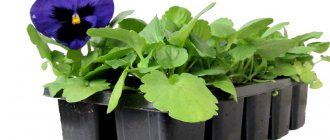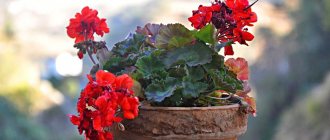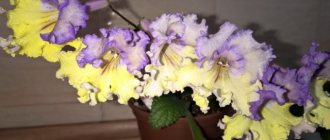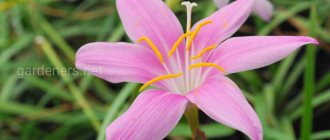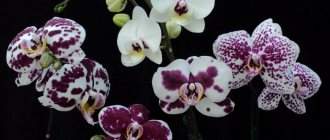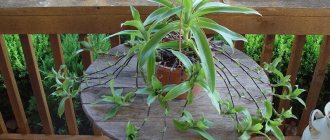The coleus flower is a perennial herbaceous plant belonging to the Lamiaceae family (in other words, Lamiaceae). Its homeland is in the Asian and African tropics, it is also found in the Indian archipelago, and also grows in Australia.
The coleus plant is a little similar to the familiar nettle, you will see this by studying the photos of flowers accompanying the article. This is a lush shrub with ribbed stems 30-50 cm high. Most often, it has a heart-shaped leaf blade with spectacular patterns and small teeth along the edge.
The leaves are pleasantly velvety to the touch, and the color is bright and contrasting. The options for foliage shades are strikingly diverse: the color of coleus can be purple, burgundy, red, pink, yellow, green, violet.
Small coleus flowers are blue or purple in color with some variation in shades. They are collected in complex inflorescences resembling spikelets. Flower growers call them “panicles” and try to remove them as quickly as possible, since such “arrows” do not have decorative value, but they take a lot of energy from the plant.
Growing coleus from seeds
You need to sow the seeds at the end of March in order to get a large and strong bush by the time it is planted in open ground. The soil mixture needs to be light and nutritious. The combination of turf soil, peat and humus will provide small seeds with everything they need for germination. There is no need to deepen the seeds into the soil; you can lightly sprinkle them with sand. Seedlings should germinate under glass in a warm place with low lighting. You need to monitor soil moisture daily.
Seed shoots
With the appearance of the first shoots, the glass must be removed and the pots moved to a well-lit place. The optimal temperature for seedlings is 19 degrees.
When the seedlings are one month old, they are ready to be planted into individual pots of small diameter (up to 7 cm). You need to care for such seedlings like an adult plant. At two months of age, the nettle should be transplanted into a larger pot with a diameter of up to 12 cm and the apical shoot should be pinched for bushiness.
Coleus: growing conditions
Sprekelia - cultivation and care in open ground
A bright and healthy appearance is due to proper care.
You can form a bush by pruning throughout the entire period of active growth.
In order for a bright bush to please with its color all season long, it is important to take care of the following conditions:
- Lighting is important to maintain the richness of the colorful colors of the leaves. In the first half of the day, lighting should be bright and abundant. After lunch, partial shade is welcome.
- The temperature for a heat-loving plant should be no lower than 18 °C in summer and no lower than 12 °C in winter.
- Watering is needed frequently and plentifully. Exot loves moisture very much, so frequent spraying will also benefit it.
- You need to maintain a bright color with regular feeding: weekly in summer and monthly in winter.
Important! Every year, after a dormant period, to stimulate the growth of beautiful shoots, it is necessary to prune the coleus. The young bush is pinched for density and bushiness. And perennial bushes are pruned to renew the crown.
Common types and varieties of coleus with photos
- Coleus Blume (aka Coleus Blume) is one of the most common varieties. Can reach 80 cm in height. It has ribbed tetrahedral stems. The photo of Coleus bloome shows that its ovoid leaves with a pointed apex can be colored in red or yellow shades, as well as white, purple or emerald with red or yellow spots. The flowers are lilac-lilac in the shape of a complex spike;
- Coleus Wizard is a large group of varieties. They grow up to 30 cm in height, have medium-sized leaves with slight pubescence. The group includes such varieties as "Coral Sunrise" ("Coral Sunrise") - shrubs of green, brown and pink colors; “Velvet Red” - bright red varieties with a pink center and veins of the same color, “Jade” - green plants with a yellow core;
- Coleus Black Dragon (Black Dragon, Dragon black) is one of the most spectacular varieties and this is easy to see from the photo. The curly and ruffled dark purple leaves have a bright or pale pink center. The shape of the leaves of the black dragon coleus can be either oblong or medium in length, with fringed edges. The inflorescences are blue and spike-shaped;
- Coleus forskohlii - also called tropical mint. It is used not only for decorative purposes, but also in Ayurvedic medicine. Externally, it is most often distinguished by a light green edge of ovoid leaves and a bright red or purple center. The shape also has notches, although not so clearly expressed;
- Coleus Hybrid - grows in height from 50 to 80 cm. The straight or curly succulent stem has fine pubescence. The wide leaves are oval or ovoid in shape and have wavy edges. The hairs on their surface are sparse, heterogeneous - long and short. The color is varied - it can be green, red, purple and other shades. The flowers are collected in a complex cluster. There are many of them, but they also do not have much decorative value;
- Coleus Rainbow is a compact variety that can stretch up only 30 cm. It got its name for the combination of many colors on its leaves. They can be green and yellow, or red and burgundy. They are broadly oval in shape, with corrugated edges. The inflorescences have a lilac-blue tint and are also collected in spikes;
- Coleus canine is a low-growing plant up to 15 cm in height. It blooms with blue, less often - yellow flowers. Most often it combines a range of green and red on its leaves. It is also famous for the fact that its smell repels cats. Therefore, it is better for the owners of these pets not to keep Coleus Canine at home;
- Coleus Avatar - has large and wide rounded leaves with a pronounced surface texture. In the middle of the leaf there is an abundance of green and yellow specks, the edges are painted dark purple. In general, it is a densely branched and fairly large bush;
- Coleus Russian size is the largest variety, its leaves reach the size of a human palm. The plant branches well, has leaves with a pronounced curly edge and a bright combination of colors that create unique patterns on the surface of the leaf.
General description of the plant
Coleus black dragon belongs to the Lamiaceae family and in nature there are about 150 species. The stems and leaves look like nettles. The plant is decorated with leaves with a velvety surface and a colorful variety of shades, thanks to which it has earned the love of flower growers.
The plant forms a lush dwarf bush with a hanging branch, 30-36 cm high, 25-30 cm wide. Black dragon is distinguished from other types of coleus by ornamental leaves of small size, corrugated structure, painted in a bright dark red color.
It is the foliage that gives the plant a certain mystery and majesty. Spike-shaped inflorescences are non-decorative and must be pruned.
Reproduction methods and features of planting coleus
There is nothing complicated about the issue of propagating coleus - there are two ways.
The first of them is sowing seeds for seedlings, the second is cuttings.
Each gardener chooses the most suitable method for propagating a flower. After all, any of them is so simple that even beginners in this matter can do it.
Propagation by seeds
The optimal time for growing from seeds is the end of March.
The correct sowing process is carried out as follows:
- Drainage is poured into the bottom of containers (boxes, pots, plastic cups).
- Fertile soil is poured on top. You can purchase it in specialized stores.
- Next, the ground is watered and the seeds are laid on the surface.
- It is recommended to lightly sprinkle them with sand and moisten them with a spray bottle.
- Containers are covered with glass or film.
- In order for seeds to germinate, they need warmth and humidity. That is why containers are removed to places where the air temperature is at least +20 +25°C.
- The first shoots will not appear too quickly. This will take approximately 7-10 days.
Once the sprouts have appeared, they require plenty of sunlight. The containers are transferred to a windowsill or other place where there is enough light.
Make sure that cold air is blowing from the window. Otherwise, there is a risk of freezing seedlings that have not yet matured.
At this stage of development, it is important to maintain a temperature of +18°C. Lack of light and high temperature will cause the seedlings to begin to stretch.
Coleus is planted in a permanent place at about the age of 1.5-2 months. During all this time, the seedlings need to be watered regularly.
In addition, if the sprouts are planted too often, they need to be planted in separate containers.
If this is not done, the seedlings will not be able to form a powerful root system.
Growing from seeds in peat tablets
In addition to growing seedlings in containers, gardeners often use other means.
For example, you can get coleus from seeds that are placed directly into peat tablets.
Eye makeup for a blue dress
In order to do this, you must follow the instructions:
- The peat tablets are watered until they become moist. The compressed peat begins to swell. The tablets increase in size - they become several times larger.
- If watering has been abundant, it is necessary to remove excess moisture.
- Planting material is distributed over the surface, leaving small gaps between the seeds. Next they are lightly pressed into the soil.
- The tablets are placed in a tray and covered with film.
- Place the container in a warm place until the seeds germinate.
When growing using peat tablets, the most important thing is to avoid over-wetting them. Drying out the peat is also undesirable.
It is necessary to regularly check the condition of the tablets and moisten them approximately once every 3-4 days.
Propagation by cuttings and further care
A fairly simple way is to propagate coleus from cuttings. You can start it from the end of February until the first days of April.
For this method, it is necessary to prepare cuttings at least 10 cm long. It is recommended to choose a strong shoot.
You need to break off the lower leaves. Next, it is placed in a container of water or soil.
With the first method, it is important to avoid direct sunlight. Also, the water must be changed regularly to clean water. It is changed approximately once every 3 days.
The procedure is repeated until roots appear.
Adding root formation stimulants to the container with water and cuttings will help speed up the process.
It could be Kornevin or Humisol.
The use of vermiculite has also worked well.
It is simply poured into a container of water and stirred thoroughly, then the cutting is dipped into the solution. After the roots appear, they are transplanted into a pot.
If the cuttings are rooted in the ground, then it is recommended to cover them with film.
The air temperature should be about +20°C.
The roots will begin to grow in 7-10 days.
After this, the seedling is ready for transplanting to a permanent place of growth.
Experienced gardeners recommend cuttings towards the end of summer.
This will allow you to propagate the flower, grow it for flower beds, flower beds, or use it as a houseplant.
As for an already full-fledged flower with foliage and a powerful root system, it requires some care. Coleus loves the sun.
If it receives plenty of light, its foliage will be colorful and its patterns clear and vibrant.
If possible, it is recommended to place the flower pot in a sunny place in the morning and move it to the shade at lunchtime.
This measure is necessary for the active growth and development of the plant. Keep a close eye on coleus. Sometimes it happens that it begins to shed some of its leaves.
This is due to a lack of sunlight.
Be sure to find a more suitable sunny place for it.
Secrets of successful planting
You can plant the plant using seeds and cuttings.
See what the professionals advise:
Growing from seeds in stages:
- Prepare the optimal substrate for sowing from sand and peat.
- Place the seed material on the prepared soil at a distance of 2-3 cm from each other and sprinkle sand on top.
- Cover the containers with transparent glass and place in a plastic bag. At this stage, the seeds need proper watering and regular ventilation.
- 15 days after the formation of the first shoots, it is necessary to pick the seedlings into separate small containers with nutritious soil to continue the growth of coleus. In this case, you need to deepen the plant into the soil until the first leaves.
- In the future, you should perform another 2-3 picks into larger containers. It is important not to forget to water young specimens every 2 days. Water only under the roots, without touching the leaves.
When the height of the bushes reaches 15-20 cm, transplant the plants into permanent pots.
The favorable period for planting a plant using cuttings is February. To do this, you should choose cuttings without flowers and buds, having two pairs of leaves. Carefully cut them off and place them in water.
After a month and a half, with the formation of the first roots, plant the cuttings in pots with soil, deepening the lower leaves. In the future, organize the same care as for adult specimens.
Signs and superstitions that coleus gave rise to
It is not known for certain why the handsome coleus “overgrown” with negative signs. Some believe that its flowering brings misfortune, while others associate the brightness of its foliage with fire. Others say that “house nettle” will bring poverty to its owner or drive a man out of the house...
However, many flower growers, communicating with colleagues on specialized forums, say that they are long-time fans and owners of a wide variety of coleus, and over all these years, none of the above-described troubles have happened to them.
Planting coleus seedlings in open ground
Coleus seedlings are planted in a permanent place when consistently warm weather arrives, not earlier. As a rule, this period occurs in mid-May and generally in the second half of the month.
The place for planting young plants should be sunny, protected from the wind, with fertile, well-drained, loose soil. In this area you need to make holes at a distance of 20-30 cm. Plants are transplanted using the transshipment method, that is, a whole earthen ball is placed in the hole, covered with earth and generously spilled with water.
Botanical description of coleus
Coleus is a plant that grows as a deciduous shrub, reaching a height of approximately 80 cm - 1 m. It comes from areas of Asia and Central Africa.
But, despite the fact that the culture was “born” in very warm tropical regions, in everyday life it is not distinguished by whimsicality. Great for home and garden growing.
At the same time, the varieties of the species are diverse, the colors of their leaves are amazing. Their shape is in the form of a wide oval, tapering slightly towards the end. The stems have 4 sides. The flowers are collected in spike-shaped inflorescences. The predominant shades are red, white, purple and brown.
Initial data
I ordered seeds for growing on a windowsill in winter, so I was guided not only by decorative qualities, but also by the size of the plant.
The declared height of the Black Dragon coleus is up to 30 cm. As for me, it’s just right for growing a neat compact bush. Package
In August 2016, I paid 45 rubles for one pack of 10 seeds. The manufacturer differs from others in that it subjects the seeds to plasma treatment to increase germination and disease resistance. I can’t say how effective it is, but, from my own experience, I didn’t have to complain about the product.
What to do after purchase
When purchasing, follow simple recommendations, here are some of them:
- A careful inspection is required; there should be no traces of diseases or pests on the leaves and stems.
- It is better to make a purchase in the spring, this will help adaptation.
- It is not recommended to purchase flowering coleus. A sudden change in conditions may have a negative impact on further growth.
- Choose a plant with several shoots, not just one, with a fluffy crown. These are sure signs of a developed root system.
- Find out about transportation. If it arrived from abroad, it needs to be replanted, since some types of soil are not intended for long-term cultivation.
New coleus requires adaptation, this process takes about 2 weeks. At this time, it should be protected from drafts, bright sunlight and, if possible, not rearranged.
When replanting, the original container is left provided that it is suitable in size. This can be easily determined by the roots; they should not be visible through the drainage holes.
Home care
Caring for the plant is not difficult, the main thing is to monitor the condition of the coleus and promptly create favorable conditions for it.
Actions after purchase
Flower growers are often faced with a situation where luxurious indoor plants purchased at a flower shop do not live up to expectations.
Therefore, in order to increase the chances of successfully replenishing the collection, it is necessary to take into account several nuances:
- Rational approach to purchasing. Houseplants should be purchased from specialized flower shops with a good reputation.
- It is advisable to purchase in the spring , since during this period the plants will more easily tolerate a change of location and will take root better.
- The flower should have a lush crown, and not a single sprouted leaf.
- You should avoid buying a flower during the flowering period, since a sudden change in conditions can negatively affect the further development of the crop.
- Before purchasing, conduct a thorough inspection of the coleus for fungal diseases and pests.
After purchase, the plant needs a couple of weeks to acclimatize. During this period, the flower should be protected from direct rays of the sun and drafts. Water moderately and try not to move.
Like any other flower, after purchase, it is recommended to replant coleus in a new soil mixture , since in trade they use transport soil that is not suitable for further cultivation. The pot does not need to be changed, provided it is the right size.
Lighting
The growth rate depends on the amount and intensity of light the plant receives. Coleus is a light-loving plant, but direct rays of the sun can leave burns on young, tender leaves. The best option would be to place the plants on the southwest or southeast side of the house or apartment.
To form a beautiful crown and uniform foliage color, it is recommended to periodically turn the pot to the light in different directions.
Important! In winter, you need to provide the plant with good lighting; a lack of light can cause the stems to stretch and the leaves to discolor.
Temperature maintenance
The main condition for successfully growing coleus is creating an optimal temperature. Coleus feels great in a room with an air temperature of +25°C, but can also develop in the range of +16 - +24°C.
In winter, it is better to keep it in a bright, cool place without drafts and sudden temperature changes. Because at low temperatures the plant can shed its leaves, rot and die as a result. And in dry, hot conditions, the flower can be attacked by pests.
Soil moisture
With water, plants receive all the nutrients for growth and development, so flowers need to be watered promptly and efficiently , taking into account several important points:
- The frequency of watering is determined based on the rate at which moisture evaporates from the soil. In summer you can water every other day. In winter you need to water about twice a week.
- It is important to water the coleus with settled water at room temperature. You can use rain, distilled or boiled water, cooled to a comfortable temperature.
Humidity level
Black dragon coleus must be provided with high air humidity. To do this, you need to periodically spray the plant using boiled water at room temperature.
This procedure must be carried out twice a week to clean the foliage of dust and stimulate the growth of new shoots. In winter, it is important to eliminate the flow of warm air from the heater and central heating radiator to the plant.
The ideal solution would be to place devices near it that will maintain an optimal level of air humidity.
The ideal humidity level for maintaining the crop is 70%.
The soil
Coleus prefers nutritious soil, which you can not only buy at a flower shop, but also prepare yourself by using leaf and turf soil, peat and sand in equal proportions. It is important to have a good drainage layer in the planting container.
You will hear other tips in this video:
Adding Nutrients
The plant is very responsive to fertilizing; the main thing is to observe the dose when applying fertilizers. This should be done at least once a week in spring and summer, when the plant is at the stage of active growth, giving preference to mineral fertilizers containing potassium. And in the autumn and winter, reduce the number of feedings to once a month.
How and where does it grow?
The flower is a perennial plant. Coleus can grow from 20 to 60 cm in height. Sometimes there are giants reaching 100 cm.
The shape of the leaf blades resembles nettle leaves in appearance. That is why the second name of the coleus plant is nettle.
Depending on the variety, the leaves are crescent-shaped or oblong. Their color may vary.
There are pink, purple, yellow, burgundy, purple, and brown shades.
The leaf mosaic is striking: you can see varieties with striped, spotted and multi-colored leaves.
Types of nettles also differ in the type of inflorescence. As a rule, they are small and can be white, blue, or purple.
Breeders have also developed varieties suitable for growing indoors. In addition, there are annual and perennial plants.
Some hybrids are not only attractive in appearance, they also have a pleasant aroma.
The plant has medicinal and beneficial properties; coleus has a bactericidal effect.
The healing magic of the plant
Coleus dragon black is considered not only a home decoration, but also a natural healer, of particular interest to people who are learning to do without pharmaceuticals, replacing them with natural medicines and a healthy lifestyle.
The benefits of the plant are determined by its chemical composition, of which forskolin is of particular value. Therefore, coleus comprehensively strengthens and restores body functions and stabilizes the functioning of important systems. When used, health improvements and rapid recovery are monitored because it:
- has a positive effect on metabolism;
- helps to better absorb vitamins and minerals;
- lowers blood pressure;
- normalizes the functioning of the digestive system;
- burns fat cells in the body.
To benefit from the healing properties of coleus, you need to take its root part, wash it thoroughly, dry it and grind it. Place the finished product in a glass jar and use it in dry form as a food additive as needed.
Advantages of the seedling method
Cuttings, like the seedling method of growing plants, take a lot of time and are associated with some difficulties. If you choose from these two well-known options, then planting with seeds is more profitable. Moreover, the process cannot be called more complicated.
The positive aspects of the seedling method were:
- simplicity of the process, easy care of the seed;
- you can decide on a permanent place for planting seedlings;
- due to preparatory measures, the plant’s immunity is strengthened;
- the ability to resist infections increases;
- fertilizers are selected independently. Therefore, this is to the benefit of adherents of folk remedies and organics;
- there is no need to carry out manipulations that can kill coleus, namely, introduce an infection.
If you decide to try cuttings, then there is no guarantee that after cutting off the top, the adult plant and the cut part will fully develop.
My tips and observations regarding growing coleus
Namely:
- Do not water with running and cold water - when walking around with a hose in the evening, you just want to sprinkle the coleus, but this is strictly forbidden. For irrigation, it is better to use only warm and settled water.
- Do not apply nitrogen fertilizers - the plant will actively grow upward, but will not produce side shoots.
- Remove weeds from the flowerbed, as they attract pests.
Many people have a question: is it possible to keep this flower at home? You can’t, but you need to keep it, because it will please the eye and decorate any windowsill even on the gloomiest day.
Growing
Sowing
On August 11, I planted all 10 seeds in universal peat soil. To my surprise, the first shoots began to appear earlier than promised on the package - on day 4 instead of 10–14. At the same time, during the day the temperature was clearly higher than the recommended 21–25 degrees - a window sill with a southern orientation. There were 8 seedlings in total.
On the 15th day, a darker center can be discerned on the first true leaves. When the seedlings were 1.5 months old, the leaves had already noticeably darkened, and the green border had become very thin.
“Snow Beauty” Chionodoxa: planting and care in open ground, tips for growing an early perennial with original flowers in the form of multi-colored stars
Seedlings of Coleus Black Dragon at the age of 1.5 months
I chose the two largest ones and placed them in 100 ml plastic cups. The coleus stayed in them until spring - by March the roots had finally entwined the earthen ball and one watering a day was no longer enough.
Care
The plants spent 8 months with me - from August to April. Apart from picking seedlings, I transplanted them only once - from a 100 ml glass to a 200 ml container. I didn’t apply any fertilizers and used the first universal peat soil I found in the store. Watering, which is typical for coleus, was required once every 1-2 days - they love water. I used backlighting in the form of an ordinary table lamp in the evening, when the sun was already setting - and even then not every day.
To form a beautiful bush, the manufacturer recommends pinching the crown. I only needed to do this once, when the trunk reached a height of about 15 cm. At the end of March, I decided to make room for hot peppers and gave away the plants. By the onset of summer, the size of the leaves on other people's windowsills had already increased and they acquired a wavy shape at the edges, as expected.
Aesthetic qualities
One Instagram follower, after seeing a photo of the plant, complained that when growing coleus with colored leaves, the result always turned out the same: a green leaf with a red center. It seems to me that the reason may be not only re-grading, but also the increased need for lighting of variegated varieties. And that's why.
Seedlings before using lighting
As the length of daylight approached its minimum, the color of the leaves less and less corresponded to the variety and became inconspicuous. Noticing this, I realized that a little more and the internodes would begin to lengthen, and the shape of the plants would lose its aesthetics, and I placed the coleus plants under the table lamp. The problem disappeared literally before our eyes, and the foliage acquired an amazingly beautiful color. Depending on the angle and brightness of the light, it shimmered from a warm dark brown to a deep burgundy purple with amethyst sparkles - sparkles: the leaves sparkled in the sun!
Coleus Black Dragon in sufficient light
Types of coleus for the garden
Coleus has more than 400 species, hybrid and specific. They are very diverse in leaf shape, color and size of the bush.
Coleus Blume
Anemones - growing and care in open ground
The founder of many hybrid varieties. The Blume variety includes many species with different colors. They are united only by the shape of the leaf - ovoid with a pointed end. The teeth at the edges are not sharp, but rounded. The colors of the leaf plates can be very diverse. This variety of coleus combines red, pink, cream, white, yellow, purple, black, brown and yellow. Grows as a garden and indoor plant. It is unpretentious in care and is often propagated by cuttings. Colorful and common varieties of Blume - dawn, fun, orange.
Coleus Black Dragon
The unusual coloring was loved by many. The leaves are dark purple-burgundy in color, sometimes with a green edge or a pink spot. The beauty of this subshrub is added by the wavy shape of its velvety leaves (a property of hybrid varieties). Used in contrasting garden compositions. Winters well on apartment windowsills. Propagated by cuttings, demanding high air humidity.
Coleus Reno or Renelta
Not a very tall shrub, more used as a hanging shrub. The color of the leaves varies, but the veins of Reno Coleus are always crimson or violet-red. The species is also interesting because by autumn it can change the color of its leaves several times.
Coleus canine
Dog coleus is popularly called spur flower or plectranthus. The plant is very similar in appearance to coleus and is just as unpretentious. The flower acquired an interesting name due to its pronounced smell. The flower begins to exude a strong aroma as soon as its leaves are touched. Spurflowers planted around the perimeter of the bed protect the harvest from animals, insects and snakes that do not like the aroma of this bush.
Coleus forskoliii
Tropical mint, native to Thailand. Used in Ayurvedic and Chinese medicine. The plant has a wide range of uses for medical purposes - diseases of the respiratory tract, cardiovascular system and digestive tract.
Important! Its decorativeness is not inferior to other varieties - a bright combination of purple and bright green colors on round leaves, similar in shape to mint.
Avatar
A variety called royal. Its leaves stand out among other species due to their large size. The color shimmers on the leaf, and the palette goes from green to dark burgundy. But his closeness to the kings ends in appearance. Avatar is also unpretentious in care. But nutritious soil and regular complementary feeding must be provided to maintain the beauty of its large leaves.
Coleus diseases and pests
- Pale coloring and the appearance of yellow spots are clear signs that the plant is suffering from direct sunlight. Don’t delay, try to move the bush into partial shade or build a canopy; in a few days the individual will recover.
- Coleus that are old or receive insufficient light stretch forward. In the first case, you can do very little: slightly increase complementary feeding and watering, improve lighting. But the second problem is easy to fix, change the location of the flower. The same phenomenon is observed in those crops that were not pruned on time. Therefore, prune the young plant before it is fully formed.
- Falling leaves indicate freezing or overwatering. It is worth noting that the same thing happens when there is a lack of water, so it is worth analyzing your last actions and understanding where you made a mistake. Afterwards it will be easy for you to eliminate it.
- Poor soil, lacking nutrients, significantly slows growth. You need to either replant the flower or buy fertilizer.
- Due to dry air, the edges of the leaves turn brown, they shrink and lose their shape. Spraying generously will help.
- Be sure to build drainage so that the liquid does not stagnate. Otherwise, the stem begins to rot.
- Pests are more dangerous for indoor crops, but garden crops are less likely to be affected by them. Aphids, whiteflies and spider mites. They infect the individual, suck out nutrients from it, which is why the coleus dies. They are destroyed by ordinary soap solution, which must be used to treat the entire above-ground part of the plant. If all the pests have not died, then after a week the procedure must be repeated. But at the same time, you need to be extremely careful so that the soap does not get on the soil, otherwise the root system will suffer. For protection, cover the ground with film, so not a single drop will seep inside.
Coleus is great for beginners, hobbyists, or experienced gardeners. This beautiful and bright flower can decorate any home.
Problems, diseases, pests
Coleus suffer from aphids, spider mites, scale insects and whiteflies. Homemade coleus is more vulnerable than outdoor coleus. To prevent damage by parasites, you need to inspect the flower more often and wash it in the shower.
Insects are found on the underside of leaves. A signal that coleus may be infected is discoloration and deformation of the leaves. For treatment, you need to cut out the affected parts of the flower and treat the plant with an insecticide.
The main growing problems and diseases are associated with defects in care:
- rotting of the lower part of the stem: stagnation of moisture due to lack of drainage;
- the ends of the leaves become brown: dry air, little watering;
- coleus leaves fall: low temperature, drafts;
- light spots are visible on the leaves: direct exposure to the sun;
- leaves lose brightness: lack of lighting;
- coleus growth slows down: soil is too poor.
Replanting and pruning coleus
Coleus is replanted in the spring; for some plants growing at home, once every 2 years is enough.
Here are some landing rules:
- When choosing a container, they are guided by the fact that the old pot should fit in the new one.
- You need to transport the plant with a small ball of earth, this will avoid damaging the roots.
- The new substrate must contain peat and humus. A layer of broken tiles or expanded clay is required at the bottom.
- After transplanting, the coleus needs to be watered generously and fertilized.
In spring, the bush needs to be formed; for this, pruning is carried out. For adult plants, this procedure will be rejuvenating. Dried and non-viable branches are removed, this activates the growth of young shoots from the root.
If you need a tall plant, then remove the side shoots. To give the bush a spherical shape, pinch the tops, and remove the inflorescences for splendor.
Without heavy pruning, the flowerbed can grow into a lush carpet.
Particularly tall and dense specimens growing at home or in the garden are best tied to supports. In this case, the inclination and direction of the bush can be adjusted.
Coleus propagation
Coleus are propagated by seeds and, mainly, cuttings, in order to avoid splitting and loss of decorativeness of the leaves.
Coleus seeds are small (3500 pieces in 1 g), they are sown in February-March-April in bowls and sprinkled with sand on top. Keep at a temperature of 20-22°C. Shoots appear on the 14-18th day. Seedlings are planted in bowls or boxes at a distance of 2x2 cm. The composition of the soil is as follows: leaf - 1 part, peat - 1 part, turf - 1 part, sand - 1 part.
In the phase of 1-2 pairs of leaves, coleus are planted in 7-centimeter pots, 1 copy each. The composition of the earth is the same. After a month, they are transferred into 9-11 cm pots. The main care of plants consists of watering and keeping them in a lighted place, since the intensity of the color of the leaves largely depends on the lighting (sun rays). Young plants are pinched for branching purposes. After 5-6 months, plants become important for decorating rooms.
Propagating Coleus Guy Grigsby and Amy Fieling
Plant cuttings begin in February, but this can be done until May. Coleus cuttings are planted in distribution boxes or directly on a rack in the sand. Rooting occurs within 8-12 days. Rooted cuttings are planted in 9-centimeter pots. The composition of the soil is the same as for picking. In order to obtain branched plants, pinch the tops of the shoots.
When caring for plants, watering, ventilation, a temperature of 16-18°C, a bright, possibly moderately sunny location are provided (with significant solar insolation, curling of the edges of the plate and discoloration of the leaf color are observed at high temperatures at night and low during the day). Coleus are characterized by intensive growth - within 3 months they are branched plants with large leaves. Then they are transferred into 11-centimeter pots.
Problems in growing
Among the problems most often encountered when growing coleus are:
- Excessive stretching of shoots. This problem occurs when pinching is not done in a timely manner, as well as in insufficient lighting.
- Fading leaves indicate too much light.
- Leaf falling occurs as a result of lack of moisture, as well as excessive soil moisture. The soil should be moderately moist.
- Yellowing and curling of the leaves is the first sign that the plant has been attacked by aphids or spider mites. If this problem is detected, it is recommended to treat the plant with a solution of laundry soap. Cover the soil in the pot with polyethylene during treatment to prevent the soap solution from getting into the soil.
Growing coleus is not a difficult process. If you follow the rules of sowing and care, growing this luxurious, bright plant will not be difficult even for a novice gardener.
Pest and disease control measures
If watering standards are violated, the roots of the plant may become rotten and the leaves will begin to fall off. You should periodically inspect the bushes and, if there are signs of disease, take measures by treating them with special preparations.
Of the pests, coleus likes mealybugs, aphids, whiteflies, and spider mites. At the very beginning, before the pest has had time to seriously infect the plant, you can use simple home remedies; at later stages, use insecticidal agents, for example, Bison, Actofit, Confidor Extra.
Folk remedies for pest control:
- Mealybug. Treating the affected areas with alcohol (wet a cotton swab) or spraying with a daily infusion of lemon and orange peel (50g per 1 liter of boiling water) will help.
- Whitefly. Pour crushed soap (laundry, tar) with water (1:6), beat with a sponge and apply foam to the site of the colony, you can spray the entire bush and water the soil around it.
- Aphid. Spraying with a solution of laundry soap (300g per 10l) or tar (100-150g per 10l) with the addition of ash. The effect is enhanced if the product is heated for half an hour. Ash can be used to pollinate the soil near the plant.
- Spider mite. A good result is obtained by treating with a soap solution, ammonia solution (30g per 10l), daily infusion of garlic (30-50g per 10l of boiling water).
Coleus planted on a balcony in a dacha will delight you with its bright variegated colors throughout the season, and when planted in an apartment it will create a summer mood, bringing home a sunny smile and, at the same time, growing and caring for it will not bring much trouble.
Summary
Coleus Black Dragon is one of the most spectacular varieties I have ever seen, not in a picture. The image on the seed packaging is not able to fully convey the shade of velvety leaves shimmering in the sun. However, the main advantage of the variety also requires appropriate conditions - without sufficient lighting, coleus can turn out completely unattractive. Since I grew this variety on the window in winter and never fertilized it, it would be biased to judge the growth rate - in my opinion, development proceeded at a completely normal pace for indoor keeping.
Definitely recommend! Including those who want to grow something beautiful from seeds, but do not yet have experience.
Mr. Summer Resident Recommends: Black Dragon Coleus - Natural Healer
Coleus, in addition to its decorative function, also provides benefits as a natural medicine. This is due to the chemical composition of the plant and the forskolin it contains.
At home, they use the root part of coleus, which is thoroughly washed, dried and ground into powder. After cooking, pour into containers and add to food. How a dietary supplement has a positive effect on all body systems:
- It affects the functioning of the thyroid gland and is involved in the burning of fat cells.
- Reduces blood pressure.
- Helps absorb vitamins and minerals.
- Helps improve digestion.
- Has a general strengthening effect.
An amazing variety of coleus, Black Dragon, has an unusual coloring of leaves that will look original both in a garden flower bed and as a window sill decoration. In addition, the substances beneficial to the body will not leave any lover of traditional medicine indifferent.
